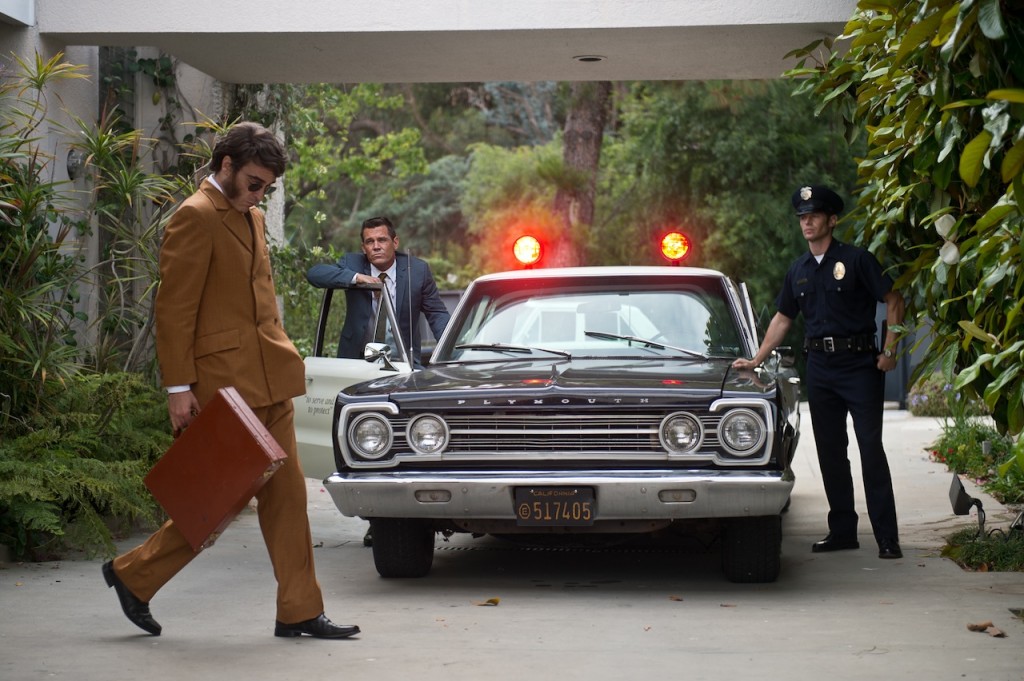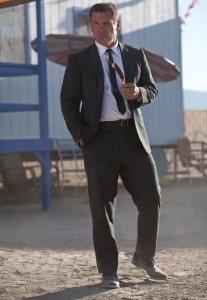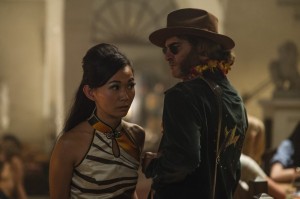 Nothing will prepare you for Inherent Vice, the latest film to come from the celebrated Paul Thomas Anderson. I tried to prepare myself for it in whatever way I could, but – after watching it – was left scratching my head but also quite engaged in a trippy way. What is Inherent Vice? People will respond to that question with varying answers. Some may say it’s pretentious or self-serving. Some may say it’s an homage to film noir. Some may say it’s overrated. Some may say it’s a love letter to California. Some may say it’s a masterpiece. Me, I say it’s mesmerizing.
Nothing will prepare you for Inherent Vice, the latest film to come from the celebrated Paul Thomas Anderson. I tried to prepare myself for it in whatever way I could, but – after watching it – was left scratching my head but also quite engaged in a trippy way. What is Inherent Vice? People will respond to that question with varying answers. Some may say it’s pretentious or self-serving. Some may say it’s an homage to film noir. Some may say it’s overrated. Some may say it’s a love letter to California. Some may say it’s a masterpiece. Me, I say it’s mesmerizing.
 In 1970 Los Angeles, private investigator and pothead Doc Sportello (Joaquin Phoenix) receives a surprise visit from former flame Shasta (Katherine Waterston). Now smitten with billionaire land developer boyfriend Mickey Wolfmann (Eric Roth), she speaks about an outlandish plot involving said boyfriend’s wife and her boyfriend, who plan to kidnap Wolfmann and commit him to a mental asylum. The two want her on their plan, and she wants Doc to prevent it. Though reluctant, Doc agrees to look into it, and along the way accepts cases that somehow end up connecting to Wolfmann. It’s a time when paranoia is running high, and Doc must navigate through the madness.
In 1970 Los Angeles, private investigator and pothead Doc Sportello (Joaquin Phoenix) receives a surprise visit from former flame Shasta (Katherine Waterston). Now smitten with billionaire land developer boyfriend Mickey Wolfmann (Eric Roth), she speaks about an outlandish plot involving said boyfriend’s wife and her boyfriend, who plan to kidnap Wolfmann and commit him to a mental asylum. The two want her on their plan, and she wants Doc to prevent it. Though reluctant, Doc agrees to look into it, and along the way accepts cases that somehow end up connecting to Wolfmann. It’s a time when paranoia is running high, and Doc must navigate through the madness.
Simply put, Inherent Vice is a film that requires at least two viewings, especially if you plan to catch it in theaters. The purpose of the first viewing is to soak in a one-of-a-kind psychedelic experience, and the second to piece a confusing narrative together. I imagine many will write the film off too easily after just one viewing, so I do encourage viewers to judge it after watching it at least twice. Cinephiles often describe mind-benders like 2001: A Space Odyssey as such, but this film is an entirely different game.
 From what I’ve heard, the film is a faithful adaptation of Thomas Pynchon’s novel of the same name, and that may not bode well for moviegoers who prefer films with tight plots. I attempted to read it last year and managed to get through a few chapters before leaving it (due to me being busy), but from what I remember reading, the novel’s scenes and tone are brought to life. Pynchon’s writing requires utmost attention, and those who watch the film will feel the same way, as it’s quite a task to make sense of it all. That being said, it’s a sprawling picture with a loose narrative, where it connects plot elements with thin strands.
From what I’ve heard, the film is a faithful adaptation of Thomas Pynchon’s novel of the same name, and that may not bode well for moviegoers who prefer films with tight plots. I attempted to read it last year and managed to get through a few chapters before leaving it (due to me being busy), but from what I remember reading, the novel’s scenes and tone are brought to life. Pynchon’s writing requires utmost attention, and those who watch the film will feel the same way, as it’s quite a task to make sense of it all. That being said, it’s a sprawling picture with a loose narrative, where it connects plot elements with thin strands.  Characters drop in and out of the story, and it’s not always clear what they do or what their relation to Doc is. To make matters more perplexing, the same characters drop names here and there, some of which are mentioned only once. To wish for subtitles is understandable. Even the inclusion of a narrator (Joanna Newsom) doesn’t quite help, and she seems to urge us to simply go along with the ride.
Characters drop in and out of the story, and it’s not always clear what they do or what their relation to Doc is. To make matters more perplexing, the same characters drop names here and there, some of which are mentioned only once. To wish for subtitles is understandable. Even the inclusion of a narrator (Joanna Newsom) doesn’t quite help, and she seems to urge us to simply go along with the ride.
There’s an irony in watching Doc follow leads that seemingly lead to nowhere but coincidentally are related to the cases he’s working on. His point of view reflects our own because they are one and the same. The people he meets and the things he witnesses befuddle him, and all he can do is be led along and try to make sense of what the hell is going on. He smokes joints and takes every drug known to man, so he’s just about stoned every step of the way, and the narrative brilliantly reflects that barely conscious state of mind. As the viewer, we know and don’t know just as much as he does. His story is just one wacky adventure; the film has the elements of film noir infused with drug-addled senses, and it’s one engrossing, trippy experience.
 A plot certainly exists in Inherent Vice, but even when it can’t be put together on the fly, something deeper stirs beneath it. As Doc bumbles around Los Angeles trying to solve his cases, we find ourselves witnessing a story of people waking up from a dream, the ’60s counterculture. A time where people preached love and peace is coming to an end (the Manson murders and arrest occurred around this time), and the fun-loving hippies are now coming to a rude awakening. A person like Doc finds this rather troublesome, and all he wants to do is to remain in that pipe dream, reluctant to face a harsh reality.
A plot certainly exists in Inherent Vice, but even when it can’t be put together on the fly, something deeper stirs beneath it. As Doc bumbles around Los Angeles trying to solve his cases, we find ourselves witnessing a story of people waking up from a dream, the ’60s counterculture. A time where people preached love and peace is coming to an end (the Manson murders and arrest occurred around this time), and the fun-loving hippies are now coming to a rude awakening. A person like Doc finds this rather troublesome, and all he wants to do is to remain in that pipe dream, reluctant to face a harsh reality.  There’s a reason why he’s constantly smoking, and why he continues to move forward with these cases, even when they get bewildering. A (somewhat unconventional) love story is at the heart of the film, seeing that Doc still pines for Shasta, the remnant of the good times that he remembers. But does he long for Shasta, or rather the lifestyle of days past that he holds in dear memory? The film is brimming with nostalgia and sadness, and even when the narrative doesn’t make sense, it’s easy to be swept up in those feelings, which play a huge part in the film’s strongest scenes.
There’s a reason why he’s constantly smoking, and why he continues to move forward with these cases, even when they get bewildering. A (somewhat unconventional) love story is at the heart of the film, seeing that Doc still pines for Shasta, the remnant of the good times that he remembers. But does he long for Shasta, or rather the lifestyle of days past that he holds in dear memory? The film is brimming with nostalgia and sadness, and even when the narrative doesn’t make sense, it’s easy to be swept up in those feelings, which play a huge part in the film’s strongest scenes.
It’s quite surprising how light-hearted and humorous the film is, and that plays a large part in making Doc’s journey so enjoyable. Almost all the characters are deluded or stupified (or perhaps plain stupid for some), and Anderson draws plenty of laughs from their antics and words. He gets his cast in on the act too, and they put in the effort and enthusiasm to ramp up the humor. Josh Brolin is an outright hoot here – the sight of his hippie-hating, macho LAPD detective suckling on a chocolate-covered banana or yelling in Japanese to a cook who clearly speaks English is enough to make anyone guffaw. Ditto Martin Short, whose dentist’s avidity for cocaine and sex makes for some memorable scenes.
 Did I mention the cast is excellent? Joaquin Phoenix, complete with bushy sideburns, slurs his lines and slacks his jaw in a loopy body performance. Supporting him is a rich cast, and although the majority of them are limited to mere cameos, all of them leave their mark in their own unique ways. Katherine Waterston maintains a alluring melancholy presence, Owen Wilson carefully accentuates his characters’ perks in a slow manner, Benicio Del Toro commands with his soft voice, and Reese Witherspoon balances tenderness with the puritanical. No one comes close to making an impression as Josh Brolin, though, as he absolutely steals his scenes in what is arguably his first truly comedic role.
Did I mention the cast is excellent? Joaquin Phoenix, complete with bushy sideburns, slurs his lines and slacks his jaw in a loopy body performance. Supporting him is a rich cast, and although the majority of them are limited to mere cameos, all of them leave their mark in their own unique ways. Katherine Waterston maintains a alluring melancholy presence, Owen Wilson carefully accentuates his characters’ perks in a slow manner, Benicio Del Toro commands with his soft voice, and Reese Witherspoon balances tenderness with the puritanical. No one comes close to making an impression as Josh Brolin, though, as he absolutely steals his scenes in what is arguably his first truly comedic role.
 Watching the film is like being transported to an era long gone. Longtime Anderson collaborator and cinematographer Robert Elswit shot the picture on film for the analog-adoring director, and to watch it in any format other than 70mm film is a disservice (yes, I’m well aware your local theater probably doesn’t screen in that particular format), as the grainy and occasionally blotty nature of celluloid impart the impression that this was shot in 1970. Wide shots, typically fixed and stable, breathlessly capture an older Los Angeles, impeccably recreated thanks to some fantastic production design. While the film’s music does have the tendency to distract from dialogue, it is very much part of the film’s soul, and Jonny Greenwood’s immersive original score – in conjunction with various songs from that era – sweep both Doc and us from scene to scene.
Watching the film is like being transported to an era long gone. Longtime Anderson collaborator and cinematographer Robert Elswit shot the picture on film for the analog-adoring director, and to watch it in any format other than 70mm film is a disservice (yes, I’m well aware your local theater probably doesn’t screen in that particular format), as the grainy and occasionally blotty nature of celluloid impart the impression that this was shot in 1970. Wide shots, typically fixed and stable, breathlessly capture an older Los Angeles, impeccably recreated thanks to some fantastic production design. While the film’s music does have the tendency to distract from dialogue, it is very much part of the film’s soul, and Jonny Greenwood’s immersive original score – in conjunction with various songs from that era – sweep both Doc and us from scene to scene.
Inherent Vice may be maddening, but it’s undeniably captivating. Sure, the dense and perhaps scattershot plot is frustrating to follow, but it does take us on a well-told metaphorical voyage, a magic carpet ride. That’s what makes Anderson’s latest film so audacious and unique. Heck, I’m already itching to get back on.
Rating: 4.0/5.0
* Photos courtesy of Warner Bros. Pictures
